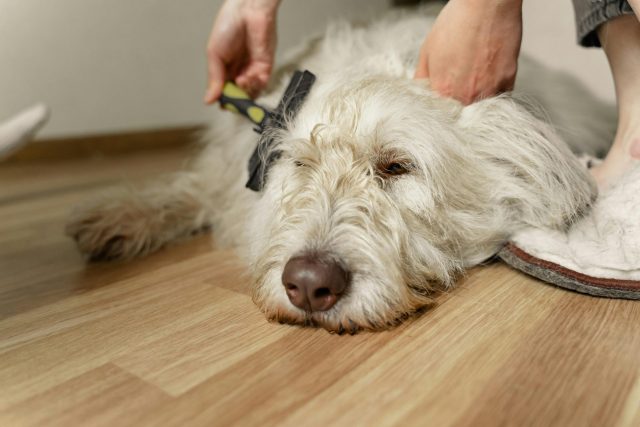Grooming your dog at home is an essential aspect of pet care that ensures your furry friend’s hygiene and strengthens the bond between you and your pet. Regular grooming can help keep your dog healthy, looking great, and feeling comfortable. Additionally, grooming your dog at home can be a cost-effective alternative to professional grooming services, which can be expensive and time-consuming.
By learning how to groom your dog at home, you can tailor the grooming sessions to fit your dog’s specific needs and preferences, making the experience more pleasant for both of you.
This guide will explore the benefits of home grooming, the essential tools you need, a step-by-step grooming process, practical tips for effective grooming, common mistakes to avoid, and when it’s best to seek professional help.

Why Grooming Your Dog at Home is Important
Grooming your dog at home offers numerous benefits beyond maintaining your dog’s cleanliness. One of the primary advantages is the cost savings. Professional grooming services can be costly, especially for long-haired or high-maintenance breeds. By grooming your dog at home, you can significantly reduce these expenses. Furthermore, regular grooming sessions at home provide an excellent opportunity for bonding with your pet. This quality time helps to strengthen the trust and relationship between you and your dog, making them more comfortable and cooperative during grooming sessions. Home grooming also lets you detect any health issues early, such as skin infections, lumps, or parasites, ensuring prompt treatment and care.
Essential Tools for Grooming Your Dog at Home
You will need essential grooming tools to groom your dog at home effectively. These include:
- Brushes and Combs: You will need appropriate brushes and combs depending on your dog’s coat type. Slicker brushes are ideal for removing loose fur and tangles, while bristle brushes are great for smooth coats. Combs help to remove mats and distribute natural oils throughout the coat.
- Clippers and Scissors: Electric clippers are useful for trimming your dog’s fur, especially for breeds with thick or long coats. Scissors are necessary for trimming around sensitive areas such as the face, paws, and tail.
- Nail Trimmers: Trimming your dog’s nails is crucial for comfort and health. Use dog-specific nail trimmers to avoid injury.
- Shampoos and Conditioners: Use a gentle, dog-specific shampoo to clean your dog’s coat without irritating their skin. Conditioners can help to keep the coat soft and manageable.
- Ear Cleaners: Regular ear cleaning prevents infections and removes wax buildup. Use a vet-recommended ear cleaner and cotton balls or pads.
Each tool is crucial in maintaining your dog’s hygiene and comfort, making the grooming process smoother and more efficient.
Learn Which Short-Haired Dogs Need Less Grooming
Step-by-Step Guide to Grooming Your Dog at Home
- Brushing: Brush your dog’s coat to remove loose fur, dirt, and tangles. Use a brush suitable for your dog’s coat type and work toward hair growth.
- Bathing: Once the coat is tangy-free, bathe your dog using lukewarm water and a gentle dog shampoo. Rinse thoroughly to remove all soap residues.
- Drying: Towel dry your dog to remove excess water, then use a blow dryer on a low heat setting to dry the coat completely.
- Nail Trimming: Carefully trim your dog’s nails using dog-specific nail trimmers. Avoid cutting too close to the quick to prevent bleeding.
- Ear Cleaning: Clean your dog’s ears using a vet-recommended ear cleaner. Apply the cleaner to a cotton ball and gently wipe the outer ear canal.
- Hair Trimming: Pay close attention to sensitive areas using clippers and scissors to trim the hair. Ensure the fur is even and free of mats.
Tips for Making Home Grooming Easier and More Effective
To make grooming your dog at home easier and more effective, follow these practical tips:
- Create a Calm Environment: Choose a quiet, comfortable space for grooming to keep your dog relaxed.
- Be Patient: Take your time and be gentle. Reward your dog with treats and praise to create positive associations with grooming.
- Regular Sessions: Groom your dog regularly to prevent matting and keep their coat healthy.
- Handle with Care: Be cautious around sensitive areas like the face, paws, and ears.
Nervous or resistant dogs should be gradually acclimated to the grooming process. Start with short, positive sessions and gradually increase the duration as your dog becomes more comfortable.
Common Mistakes to Avoid When Grooming Your Dog at Home
Avoid these common mistakes to ensure a safe and effective grooming session:
- Skipping Brushing: Always brush your dog before bathing to prevent mats and tangles.
- Using Human Products: Only use dog-specific grooming products to avoid skin irritation.
- Neglecting Nails: Regularly trim your dog’s nails to prevent discomfort and health issues.
- Rushing the Process: Take your time to ensure thorough grooming and a positive experience for your dog.
Discover Dog Breeds With High Grooming Needs
When to Seek Professional Help
Sometimes, it’s best to seek professional help grooming your dog. Consider taking your dog to a professional groomer if:
- Your dog has severe matting or tangles that are difficult to remove.
- Your dog is aggressive or extremely anxious during grooming.
- You are unsure how to groom specific breeds with unique coat requirements.
- Your dog requires specialized grooming for health issues or medical conditions.
By understanding when to seek professional assistance, you can ensure your dog receives the best possible care.
Find Out Which Dog Breeds Are Easiest To Bathe
In conclusion, grooming your dog at home is a rewarding and cost-effective way to maintain its health and appearance. With the right tools, knowledge, and approach, you can provide your dog the necessary care while strengthening your bond.

 Toledo, United States.
Toledo, United States.